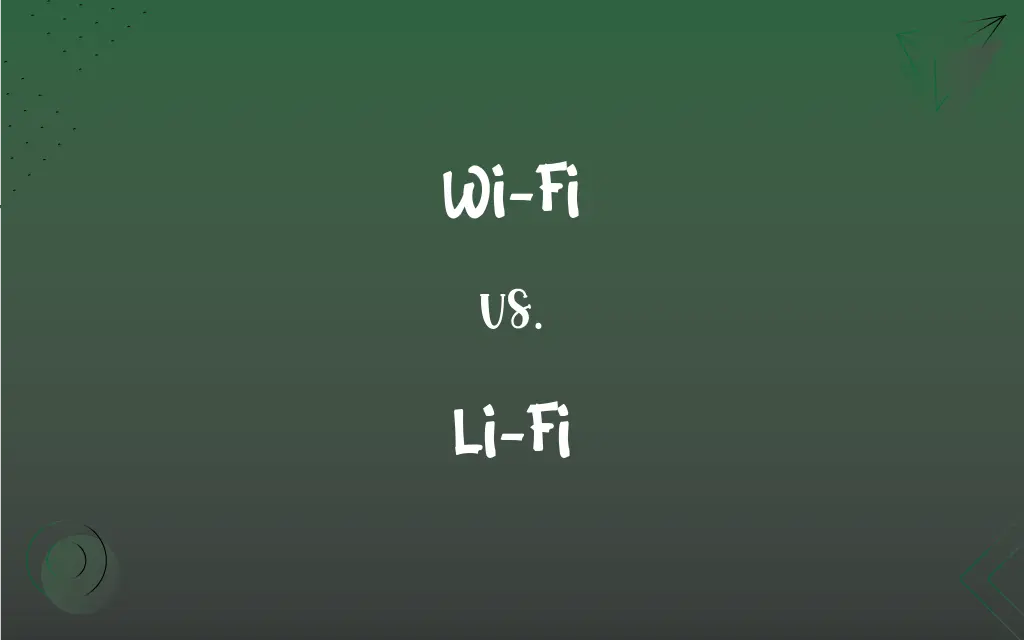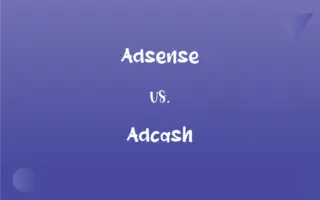Wi-Fi vs. Li-Fi: What's the Difference?
Edited by Aimie Carlson || By Harlon Moss || Updated on October 20, 2023
Wi-Fi uses radio waves for wireless data transmission, while Li-Fi uses visible light from LED bulbs.

Key Differences
Wi-Fi, a term most people are familiar with, stands for "Wireless Fidelity." This technology employs radio waves to transmit data wirelessly between devices and a router, facilitating internet connections. It is prevalent in homes, offices, and public spaces, enabling users to access the internet without physical connections. On the other hand, Li-Fi, or "Light Fidelity," is a newer technology that uses visible light from LED bulbs to transmit data. The primary mechanism involves modulating the light frequency faster than the human eye can perceive.
One of the most striking differences between Wi-Fi and Li-Fi is their transmission medium. While Wi-Fi relies on the electromagnetic spectrum's radiofrequency part, Li-Fi uses the visible light portion. This difference leads to some inherent advantages and challenges for both. For instance, Li-Fi can boast faster data transfer rates because visible light has a higher frequency than radio waves. However, because light cannot penetrate walls, Li-Fi has a more limited range compared to Wi-Fi.
When considering applications, Wi-Fi's widespread adoption makes it the go-to choice for general internet access in various environments. It can penetrate walls, making it suitable for entire buildings. In contrast, Li-Fi, due to its limitation of not passing through opaque objects, is ideal for more secure environments where data confinement is necessary. This property can be advantageous in places like hospitals or military installations where data security is paramount.
While both Wi-Fi and Li-Fi offer wireless data transmission, their methodologies, strengths, and weaknesses vary considerably. As technology progresses, it's conceivable that Li-Fi might find broader applications, complementing Wi-Fi in specific scenarios, or perhaps even presenting a viable alternative in certain environments.
Comparison Chart
Transmission Medium
Radio waves
Visible light from LED bulbs
ADVERTISEMENT
Penetration
Can pass through walls
Cannot pass through opaque objects
Data Transfer Speed
Generally slower than Li-Fi
Potentially faster than Wi-Fi
Interference
Susceptible to electronic interference
Minimal interference from non-light sources
Application Scope
Widespread in various environments
Limited but growing, ideal for secure areas
Wi-Fi and Li-Fi Definitions
Wi-Fi
A means of connecting devices wirelessly to the internet.
Without Wi-Fi, he had to rely on mobile data.
ADVERTISEMENT
Li-Fi
An emerging tech offering internet connectivity using visible light spectrum.
In the tech seminar, they discussed the future implications of Li-Fi in smart homes.
Wi-Fi
A standard for transmitting data over a wireless network.
The coffee shop offers free Wi-Fi to its customers.
Li-Fi
A wireless communication method utilizing LED bulb light modulation.
His research on Li-Fi showed potential for faster internet speeds.
Wi-Fi
A technology using radio waves to provide wireless internet connectivity.
She connected her laptop to the hotel's Wi-Fi network.
Li-Fi
A means of transmitting data using light fluctuations imperceptible to the human eye.
She was amazed at how Li-Fi could transfer data using just a light bulb.
Wi-Fi
A system that eliminates the need for physical internet cables.
Thanks to Wi-Fi, their home was free of messy cables.
Li-Fi
A technology using visible light for high-speed wireless data transmission.
The new startup showcased their Li-Fi based product at the tech expo.
Wi-Fi
An ubiquitous method for devices to access the web wirelessly.
The airport's Wi-Fi allowed her to check her emails before her flight.
Li-Fi
A secure alternative to Wi-Fi, constrained by light's limitations.
The military base considered Li-Fi for its secure communication needs.
Wi-Fi
Alternative spelling of Wi-Fi
FAQs
Can Li-Fi work in the dark?
No, Li-Fi requires light to transmit data.
How does Li-Fi transmit data?
Li-Fi uses visible light from LED bulbs to transmit data.
How secure is Li-Fi compared to Wi-Fi?
Li-Fi can offer more secure data transmission since light doesn't pass through walls.
Is Wi-Fi more widespread than Li-Fi?
Yes, Wi-Fi is currently more prevalent than Li-Fi.
Why isn't Li-Fi as common as Wi-Fi?
Li-Fi is newer and has certain limitations, like not working through walls, making its adoption more niche.
Can Wi-Fi signals pass through walls?
Yes, Wi-Fi signals can penetrate walls.
Where might Li-Fi be especially useful?
In settings requiring high data speeds or enhanced security, like hospitals or military installations.
What's a significant limitation of Li-Fi?
Li-Fi cannot transmit data through opaque objects or in the absence of light.
Which technology is older, Wi-Fi or Li-Fi?
Wi-Fi is older and more established than Li-Fi.
Do all devices support Li-Fi?
No, devices need specific hardware to support Li-Fi.
Is Wi-Fi faster than Li-Fi?
Generally, Li-Fi can achieve faster data transfer rates than Wi-Fi.
Are there devices that solely use Li-Fi?
While some devices are Li-Fi enabled, most currently complement it with other technologies like Wi-Fi.
Can Li-Fi replace Wi-Fi in the future?
While Li-Fi has advantages, it's more likely to complement Wi-Fi in specific scenarios rather than replace it entirely.
How does Wi-Fi work?
Wi-Fi uses radio waves to wirelessly transmit data between devices and a router.
Are there health concerns with Li-Fi?
Currently, there are no significant health concerns associated with Li-Fi as it uses harmless visible light.
Can Wi-Fi and Li-Fi work together?
Yes, they can complement each other in hybrid systems to maximize strengths.
What does Wi-Fi stand for?
Wi-Fi stands for "Wireless Fidelity."
What causes interference in Wi-Fi signals?
Electronic devices, other Wi-Fi networks, and physical obstructions can interfere with Wi-Fi.
What's a main advantage of Li-Fi?
Li-Fi offers faster potential data transfer speeds and increased security.
Can normal LED bulbs be used for Li-Fi?
While the concept uses LED bulbs, Li-Fi requires specialized LEDs for data transmission.
About Author
Written by
Harlon MossHarlon is a seasoned quality moderator and accomplished content writer for Difference Wiki. An alumnus of the prestigious University of California, he earned his degree in Computer Science. Leveraging his academic background, Harlon brings a meticulous and informed perspective to his work, ensuring content accuracy and excellence.
Edited by
Aimie CarlsonAimie Carlson, holding a master's degree in English literature, is a fervent English language enthusiast. She lends her writing talents to Difference Wiki, a prominent website that specializes in comparisons, offering readers insightful analyses that both captivate and inform.































































